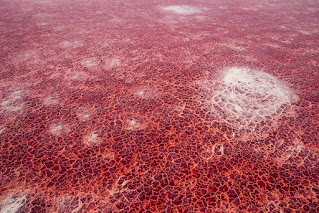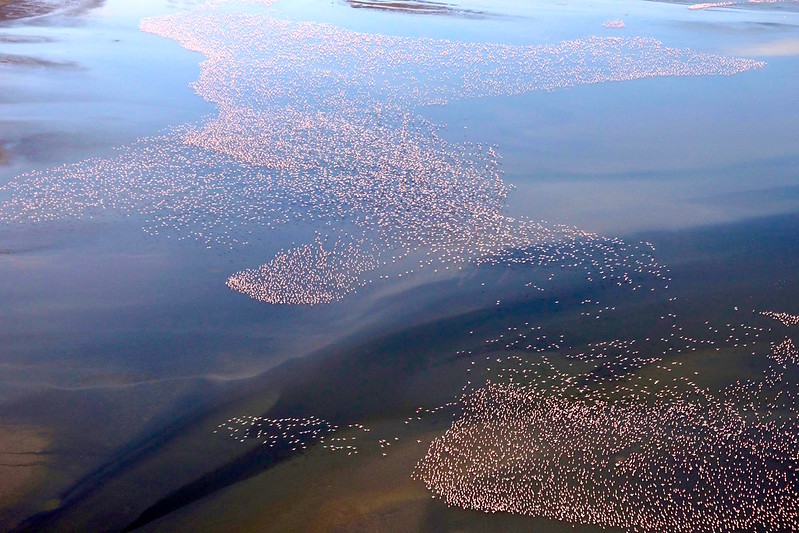Lake Natron, located in northern Tanzania near the border to Kenya and in the East African Rift System is 113 km northwest of Arusha. It is approximately 57 km in length, 22 km in width, and has salt, soda, magnesite and other deposits. The warm waters of the lake are a breeding ground for Rift valley flamingos. The lake's southeast edge is home to the Gelai volcano (2,942 m). The Natron (or Peninj) mandible was discovered by archaeologists just west of Lake Natron. This preserved fossil hominid skull contains all of its adult teeth. Australopithecus boisei was assigned the specimen.
Lake Natron
The Southern Ewaso Ng’iro River in central Kenya is the main water source for the lake, as well as mineral-rich hot springs. It is only three metres deep. The lake's width can vary depending on its water level. Around the lake, 800miles of rainfall is received annually. Its seasonal rainfall occurs mainly between December-May. The lake is frequently over 40°C.
Evaporation has left behind high levels of sodium carbonate decahydrate and trona (sodium squicarbonate trihydrate). The lake can have a pH greater than 12. The surrounding bedrock is composed mainly of trachyte lavas, which were formed during the Pleistocene. The lavas are rich in carbonate but have very low levels of calcium and magnesium. This has allowed the lake to become a caustic, alkaline brine.
Deadly lake in Tanzania
It is very dry. The lake gets less than 500mimetres of rainfall in non-El Niño year. Evaporation is usually greater than the amount, so the lake relies upon other sources (such as the Ewaso Ng'iro River in the north end) to keep it hydrated through the dry season.
The lake's unique chemistry is due to the unusual region's volcanic activity. Molten mixtures of calcium carbonate and sodium carbonate salts are produced by volcanoes like Ol Doinyo Lengai, which is located about 20 km to the south. Through a series of faults, the mixture flows through the ground and ends up in over 20 hot springs.
Although the environment is harsh enough for most species of life, some species can take advantage of it. Small, salty pools of water can fill with blooms of Haloarchaea--salt-loving microorganisms that impart the pink and red colours to the shallow water. Flamingos use the area to nest when the waters recede in the dry season. The perennial moat-like channels that surround the water and the pools of water protect it from predators.
What makes Lake Natron so special?
The reddish-coloured lake is due to salt-loving microorganisms known as halophiles. These organisms thrive in the alkaline waters of the lake and produce reddish pigments. This colour gives the lake its salt crust red. However, the salty crust changes over time giving the lake a unique appearance.
The terminal lake is located in an area with low rainfall and is fed by small rivers and hot springs. The lake's water does not flow to the sea or rivers. Lake Tanzania is made hostile by the presence of volcanic ash from the Great Rift Valley.
Natron is left in its bed due to high levels of evaporation. Natron, the name of the lake, is a mineral salt used by ancient Egyptians for mummification. Natron is both a drying and anti-bacterial agent. So, a body can be immersed in it to absorb all moisture.
Lake Natron calcified animals — Because of the unique chemical composition of the Tanzania lake Natron, animals that are killed here can become calcified statues over time. This is due to the layers of sodium bicarbonates and sodium carbonates that are encrusted on the carcasses.
Lake Natron Calcified Animals
Many are inhospitable, but a few thrive
Lake Natron, despite having the most alkaline water, supports an ecosystem that includes salt marshes, freshwater wetlands, flamingos, and other wetland bird species. The lake's hot spring inlets are home to an endemic fish species, the alkaline tuna.
Lake Natron Flamingos — Lake Natron in Tanzania is home to 75% of the world's Lesser Flamingoes. These birds can eat the algae and tilapia because of the high salt content of the lake. Bird watchers around the world love the lake's spectacle of large numbers of flamingoes strutting about, often called the "pink parade". Because of its unique biodiversity, Lake Natron was included on the Ramsar List of Wetlands of International Importance. It has also been designated as an important ecoregion of the World Wildlife Fund. This lake is definitely on the list of the most extraordinary places in the world.
Lake Natron Calcified animals colour
SOURCE → WIKIPEDA / BRITANNICA / EARTHOBSERVATORY / THEGUARDIAN / CURLYTALES
















No comments:
Post a Comment